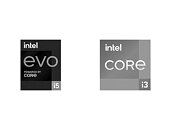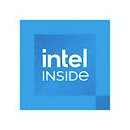- Joined
- Oct 9, 2007
- Messages
- 47,895 (7.37/day)
- Location
- Dublin, Ireland
| System Name | RBMK-1000 |
|---|---|
| Processor | AMD Ryzen 7 5700G |
| Motherboard | Gigabyte B550 AORUS Elite V2 |
| Cooling | DeepCool Gammax L240 V2 |
| Memory | 2x 16GB DDR4-3200 |
| Video Card(s) | Galax RTX 4070 Ti EX |
| Storage | Samsung 990 1TB |
| Display(s) | BenQ 1440p 60 Hz 27-inch |
| Case | Corsair Carbide 100R |
| Audio Device(s) | ASUS SupremeFX S1220A |
| Power Supply | Cooler Master MWE Gold 650W |
| Mouse | ASUS ROG Strix Impact |
| Keyboard | Gamdias Hermes E2 |
| Software | Windows 11 Pro |
EVO is likely to become a prominent client-segment processor brand by Intel as it wades into the post-Core product generation. Intel just registered a large tranche of trademarks and logos with the USPTO. It begins with a re-design of Intel's corporate identity from the ground-up, including the company's main logo. A clean new typeface replaces the one Intel has been using since the original Core i7 from a decade ago. The brands are placed with simple geometric backgrounds with fewer color gradients. The brand extension (i3/i5/i7/i9) is located at the bottom-right corner.
The distinction between two logos, "EVO Powered by Core" and just Core i3, caught our eye. We speculate that EVO could refer to a new category of Hybrid processors (chips with more than one kind of CPU core), and could debut with "Alder Lake." The non-EVO chips could have only one kind of CPU core, and given the timing of this trademark application (July 2020), we expect it to debut only with the processor that succeeds "Tiger Lake," as notebooks based on the new chips may already be under mass-production. In any case, it's only a matter of the notebook ODM (eg: Quanta, Compal, Foxconn, etc.,) placing a sticker on the product or its packaging. It's also interesting to note the "powered by Core" subtext in the EVO branding. Intel could be using this to transition between the two brands.


Update 20:02 UTC: Added registration data from US Patent Office:


View at TechPowerUp Main Site
The distinction between two logos, "EVO Powered by Core" and just Core i3, caught our eye. We speculate that EVO could refer to a new category of Hybrid processors (chips with more than one kind of CPU core), and could debut with "Alder Lake." The non-EVO chips could have only one kind of CPU core, and given the timing of this trademark application (July 2020), we expect it to debut only with the processor that succeeds "Tiger Lake," as notebooks based on the new chips may already be under mass-production. In any case, it's only a matter of the notebook ODM (eg: Quanta, Compal, Foxconn, etc.,) placing a sticker on the product or its packaging. It's also interesting to note the "powered by Core" subtext in the EVO branding. Intel could be using this to transition between the two brands.


Update 20:02 UTC: Added registration data from US Patent Office:


View at TechPowerUp Main Site





 .
.